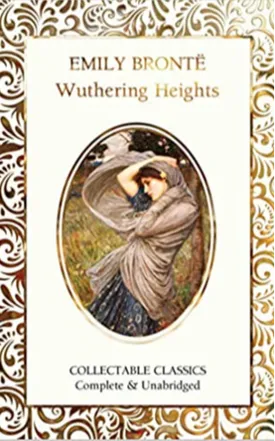The majestic and powerful Wuthering Heights by Emily Brontë is one of the most beloved classic novels of all time. Its themes of revenge, passion, love, and nature speak to generations of readers and continue to inspire new generations of readers.
The novel tells the story of Catherine Earnshaw and Heathcliff, two children born into different classes of society who fall fiercely in love and try to transgress the barriers of their upbringing. In a mesmerizing and dark narrative, Brontë portrays their tumultuous relationship and its dangerous consequences for themselves and for those around them.
The novel is set on the windy and isolated moors of Yorkshire in the early 19th century. Wuthering Heights is the residence of the Earnshaw family. It is a house built of stone and set high on a hill. The house is perched on the heights of the moors, and winds frequently howl around and through it, as if they are trying to convey the unrest and stormy emotions of its inhabitants. The landscape of the moors is an important and powerful character throughout the novel, revealing the wild and passionate emotions of the characters.
The novel begins when the young orphan Heathcliff is brought to Wuthering Heights by the Earnshaw patriarch, Mr. Earnshaw, who intended him to be a companion for his own children. Cathy, the headstrong, wild daughter, is immediately taken with the dark, moody boy and the two form an emotional bond. They are inseparable friends and confidants, united by their shared passion for one another and for the outdoors.
Eventually, however, their class difference imposes an unhappy conclusion to their relationship when Cathy's father wants his daughter to marry the wealthy Edgar Linton and not the poor Heathcliff. Although both of them are angry and heartsick, Catherine decides to accept the proposal, prompting a vengeful Heathcliff to leave Wuthering Heights.
Heathcliff's absence sets off a chain of events that will bring both misery and salvation to the characters. Years later, Heathcliff returns to wreak havoc upon his old home and the people who still inhabit it. Through his machinations and manipulation, Catherine’s daughter, Catherine Linton, and Heathcliff’s own son, Linton Heathcliff, are married and brought to Wuthering Heights in an attempt to reclaim what Heathcliff believes is rightfully his.
The novel reaches its final climax when Heathcliff is able to make amends with the departed Spectors of both Wuthering Heights and Thrushcross Grange, with an understanding that Cathy and Heathcliff will “meet on the moors” in death.
Wuthering Heights is a powerful condemnation of the class system and of how passionate relationships can be corrupted by money, power, and social class. The novel shows how class boundaries can create very real hurt and suffering, and how those often oppressed by society can become its oppressors in turn. Brontë brilliantly uses the natural world of the moors and its wild winds to represent the unbridled emotions of Heathcliff and Cathy.
The novel is ultimately a story of love conquering all, of forbidden love that survives death and transcends all barriers of class. It is one of the most powerful and intense stories of love ever written and has been adapted for film and television many times, demonstrating its enduring and universal appeal. Its themes of passion, nature, and revenge have marked it as one of the greatest classics of the English language.

